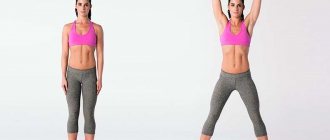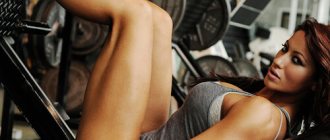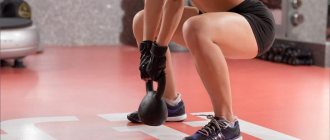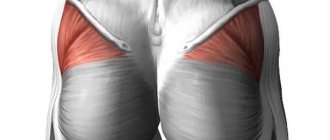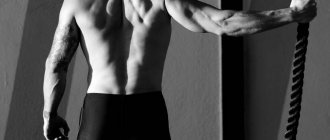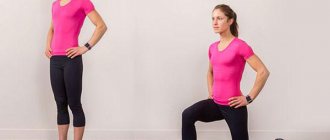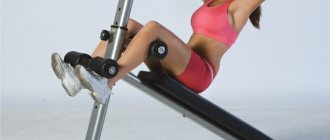In any weight loss program, the emphasis is on physical activity and proper nutrition. An excellent assistant in this difficult task is a cardio stepper, which imitates steps on the steps of a staircase. Walking up the stairs puts stress on the leg muscles, increases energy consumption, and improves blood circulation.
Walking up and down the stairs of a high-rise building is not particularly convenient, but you can “step” on a stepper right at home. A properly selected exercise program will help you lose weight, lose extra pounds on your stomach, hips, and tighten your buttocks.
What is a stepper - description and principle of operation
“Shagovik” is a simulator from the group of cardio equipment, equipped with a special pedal mechanism. Additionally, the kit may include handrails and expanders.
The simulator gives a load to the lower body (legs), allows you to work out ligaments and joints. Imitation of climbing the steps of a staircase is a good workout for the cardiovascular system, pumping up the legs and buttocks, abdominal muscles, thighs, and burning calories.
Special stepper exercises are included in rehabilitation programs for patients with musculoskeletal problems.
What is it for?
A platform with pedals is a classic, but not the only option for a stepper. Using such a simple exercise machine, the legs alternately work (“walk”), which increases endurance, improves blood circulation, and tightens muscles. It has been proven that when training on a stepper machine, the joy hormone dopamine is produced, which is responsible for the normal functioning of the heart, brain activity, and psycho-emotional background. This is an excellent prevention of despondency, depression, and bad mood.
According to reviews from those involved, the greatest effect is achieved by training of medium and low intensity. At the same time, unlike real steps on stairs, the load on the joints is minimized (the feet fit tightly to the pedals). Muscle tissues are toned, acquiring clear definition and elasticity.
In addition to the classic ones (mechanical or electromagnetic), there are balancing, rotary, and stair steppers. Balancing pedals have movable pedals, so walking becomes slightly more difficult and involves rolling from foot to foot. Coordination and sense of balance improve, additional muscle groups are loaded. Rotary models (as the name implies) are walking with body turns, and these are the kind of exercise machines that are needed to get rid of “hanging” sides.
What it pumps and what muscles it uses
The number of muscles involved when training on a cardio machine depends on its type. But, in general, when practicing on a stepper, the following “work”:
- gastrocnemius
- hip and knee extensors and flexors
- gluteal (small, medium, large0
- double-headed
- quadriceps
- feet
- medial wide
- lateral
- semitendinosus
By choosing a step machine with expanders or a balancing, rotating model, it is easy to engage the muscles of the abs, back, and arms. To begin with, eliminate (if required) excess fat by practicing minimal exercise for the maximum possible duration. Then they begin training, as a result of which a beautiful relief is formed.
Mini-exercise machines that take up little space are suitable for the home and, moreover, will not make a serious hole in the family budget. Simple “stepper” models cost from 3,500 to 5,000 rubles.
Why stepper?
- The simulator simulates walking up a flight of stairs, and if you have ever climbed the stairs, then you know for sure that this is an energy-consuming activity. So the stepper will not leave your muscles indifferent and will make calories burn with terrible force.
- Using the exercise machine, you can pump up your legs and buttocks well - the cherished goal of many girls. The work also involves the back and abdominal muscles, which stabilize the body while moving on the stepper.
- The exercise machine puts less stress on the joints, since the foot practically does not leave the pedal during movement. Exercises on the simulator are often used as rehabilitation for patients with musculoskeletal problems.
- Thanks to the large number of varieties of step machines - steppers with handrails, rotary and mini-steppers, you can choose a machine that meets your requirements and financial capabilities.
- For example, a ministepper is suitable for practicing at home and takes up minimal space.
- A stepper with handrails will give you a wide range of training options, such as varying intensity and the ability to customize step depth, pedal incline and resistance.
- The rotary stepper will force the rectus and oblique abdominal muscles to actively work. This will make your tummy look more toned.
How to exercise on a stepper at home to lose weight
Proper training is the key to a good mood and excellent results. Therefore, before stepping on the stepper pedals, carefully study the recommendations and useful tips, be sure to precede the exercise with a light warm-up. The simulator is simple, but the effect is achieved only with a competent approach. You need to work on the step machine wisely. Start without haste, gradually increasing the load.
Be sure to monitor your heart rate using information from the simulator monitor or heart rate monitor data.
The duration of initial classes is 12-15 minutes at low intensity. The time is increased gradually, bringing it to approximately 40-60 minutes. The number of heartbeats is determined, calculating it using the formula known to many: 220 beats per minute minus age (number of years). Indicators should not exceed the specified values, go beyond the age intervals:
- for beginners – 100-110 beats per minute
- 120-135 blows – for people who are partially prepared for stress
If the heart rate is low, the effectiveness of exercise will be low; high heart rates indicate overload. Breathing, which should be calm, even, without disruptions, also indicates overload.
Before training on a stepper, warm up for 5-12 minutes to warm up and prepare the muscles.
The warm-up complex includes:
- simple physical exercises (foot rotations, leg swings, arms, 5-10 squats, bends)
- easy jogging
- rotation
- jumping rope
The same thing - after training, finish with muscle stretching (cool-down duration - 10 minutes). Warm up smoothly, without sudden movements, feeling slight tension.
For exercise, choose walking or running, be sure to reduce the pace towards the end of the workout. Basic rules for working on the simulator:
- smooth movements
- straight back
- tense abdominal muscles
- tight, complete contact of the foot with the pedal surface
- slight bending of the legs, while the knees should not extend beyond the toes of the steps on the platform
- platform boundaries
- feet stand straight, without turning inward or to the sides
- knees bend moderately, straighten moderately and never come together
All these moments are clearly controlled, otherwise the effect of the lesson will disappear. Types of load on the stepper:
- straight body - the front surface of the thigh, lumbar region are loaded
- torso slightly bent forward - load on the back of the thigh and gluteal muscles
When working on a simulator with handrails, control the load on your hands, avoiding overexertion. Towards the end of the lesson, the pace is gradually reduced and breathing is restored.
Any cardio training must be combined with proper nutrition programs. You should not start exercising immediately after eating, or consume a lot of carbohydrates. It is recommended to eat approximately 1.5-2 hours before class, and after training (30-40 minutes) to have a snack with lactic acid products and apples (can be replaced with citrus fruits).
You can't exercise on the exercise machine before bed. The optimal interval is 3-4 hours before bedtime. Be sure to alternate loads with work on other types of exercise equipment, as well as take rest during the week between classes. An approximate training regimen is 3-4 times every 8-10 days.
How to properly train on a stepper?
Let's pay attention to some technical subtleties that should be followed when performing exercises on the stepper.
- Place your feet so that your feet are parallel to each other and fully in contact with the pedals.
- Throughout the entire exercise, keep your back straight with a natural arch in your lower back.
- Lean your body forward slightly.
- Do not lean on the handrails - this will reduce the strain on the muscles of the legs and buttocks.
- Before you begin the exercise, do a five-minute warm-up and stretching routine.
- Start and finish the exercise at a slow pace.
- Start with ten-minute sessions and gradually increase their duration.
- Do not eat food an hour to an hour and a half before and half an hour to an hour after exercise.
- During the exercise, alternate your walking pace.
- Don't step on the stepper three hours before bed.
- Make sure that the room you work in has good ventilation, but there should be no draft.
- Do not bring or straighten your knees throughout the exercise.
- Tighten the muscles of your legs, buttocks and thighs.
- Start with level 3–5 load.
- Work out 3-4 times a week, taking a rest day between workouts.
- If possible, alternate training on different types of steppers.
- Having reached the maximum in exercises on the stepper, include exercises on other simulators in your training.
Video: How to exercise on a stepper
Stepper exercises for slimming thighs and buttocks
Stepper exercise machines are recommended for those who want to lose extra pounds, gain a slender figure, and tighten their buttocks. How the process works:
- strengthening (pumping) muscles
- increased physical activity
- burning calories
- skin tightening
It is advisable to use various types of training, but if you work only on a step machine, then the total duration of a standard lesson should be at least 60 minutes. This time is approached gradually, without thoughtlessly increasing the load.
Approximate program (it is assumed that training on the stepper has already been carried out):
- five minutes walk at a calm pace. Arms bent at elbows
- gradual acceleration of the pace (over 4-5 minutes)
- brisk walking (1 minute)
- smooth transition to slow walking (within 3-4 minutes)
- calm step on the stepper (5 minutes)
- break (1 minute)
A new approach according to the given diagram. In total, per lesson – 3 approaches with full execution of exercises.
When walking, use your arms: work with dumbbells or expanders. Simple exercises:
- biceps curl
- rise in front of the body
- raising your arms to the sides
Standard steps are taken with a straight body, heavy steps - with the body bent forward.
In addition to losing excess weight, the stepper pumps up the gluteal muscles well. Many women dream of a seductive, elastic butt, for which they exhaust themselves with long workouts. But you need to know that the appearance of the buttocks depends on the width of the pelvic bones, on the shape of the three paired gluteal muscles, which are determined at the genetic level. Therefore, you need to train correctly, prior to pumping up your muscles with basic and aerobic exercises.
It is necessary to train the gluteus medius muscle not only for the attractiveness of the “fifth point”. Training straightens your posture, improves coordination and stabilization of the body during movement, and eliminates pain and arthrosis of the hip joint.
Sample program for the buttocks
1 Week
- warm-up 10 minutes
- one minute walk on a stepper (approximately 48-50 steps)
- rest (1 minute)
- walking (60 steps) 1 minute
- rest (1 minute)
- new approach for 2 minutes (60 steps)
- rest (1 minute)
- walk (50 steps), exactly one minute, rest.
2 week
A complete repetition of the first week's scheme.
3 week
- warm-up 10 minutes
- walk a minute (50 steps)
- rest (1 minute)
- walk two minutes (65 steps)
- rest (1 minute)
- walk 2 minutes (70 steps)
- rest (1 minute)
- walk a minute (65 steps)
- rest
- walk for a minute (65 steps).
4 week
- warm-up 10 minutes
- walk three minutes (60 steps)
- rest (1 minute)
- walk two minutes (65 steps)
- rest
- walk two minutes (70 steps)
- minute rest
- walk two minutes (70 steps)
- rest
- walk two minutes (70 steps).
The result, provided that you practice correctly and regularly and follow the approach scheme, is noticeable within 2-2.5 weeks. Starting with home exercise equipment, you can later master large steppers in the fitness room.
A couple of good tips
If increasing endurance is not the goal, I would recommend doing a set-and-rest method. You can load the leg muscles for 30-60 seconds, then give yourself a rest for 1 minute and repeat the circle.
Otherwise, you can organize a lesson if you count not seconds, but steps on a stepper. For example, plan a set of 5 sets of 50 steps and minute breaks for rest.
Warming up on a stepper is a great way to start strength training with weights. This warm-up should be done for 10 minutes to start walking with an increased heart rate.
The most common mistakes beginners make when practicing on a stepper are full extension of the legs at the knee joint and bringing the knees closer together while walking. You definitely need to make sure that this does not happen, otherwise you can harm your knees and get pain.
Don't forget that the stepper is ideal for pumping up the gluteal muscles. This video shows a very effective technique.
Exercises for losing weight on the stomach and sides
To pump up the muscles of the upper body and shed extra pounds from the sides, they work on rotary steppers with expanders. If the model is classic, then arm exercises with weights or dumbbells are added to the basic walking programs.
Approximate training program with expanders (based on basic stepper exercises):
- walking with arms pulled back
- stretching arms forward and back
- “scissors” (swings in front of the body)
- raising elbows with bent arms)
Start with simple exercises, gradually increasing the complexity and number of approaches. Exercises are performed 18-20 times, the number of approaches is 2-3. The load is controlled by gradually increasing and applying increased effort when performing exercises. The result is a toned figure, “disappearance” of the tummy, and a beautiful silhouette.
Is it possible to pump up your butt on an ellipsoid?
An ellipsoid is a device for sports training that allows you to reproduce walking or running, eliminating dynamic stress on the joints. Its peculiarity is that the muscles of both the lower and upper parts of the body are pumped, although to a lesser extent. Since we are more interested in whether it is possible to pump up the buttocks on the elliptical, let's look at a table that shows the muscles of the lower body involved during the workout:
| Group of muscles being loaded (abbreviation “m”) | Conditions for muscle growth |
| large gluteal m. | with an increase in the angle of inclination, the load increases, as well as the development of gluteus maximus |
| m. anterior thighs | provided you increase the intensity of your workouts, you can work out almost as well as on an exercise bike |
| m. back of thighs | are loaded most actively when the angle of inclination increases, as well as when moving in the opposite direction |
| m. shins - anterior tibialis, soleus, gastrocnemius | are well developed under intense loads and alternating movements forward and backward |
The table confirms the possibility of pumping up your butt on an elliptical trainer. All that remains is to pay more attention to studying training techniques.
Common mistakes when exercising on a stepper machine
Many people think that “stepping” on a stepper is easy and simple. But in fact, beginners often make mistakes in exercise programs, and then complain about the lack of the desired result. An incorrect approach leads to painful sensations (back, knees) and muscle stiffness.
Main mistakes:
- valgus movement (bringing the knees together). The knees should move parallel; at the slightest hint of approaching, force is applied and this is not allowed. Otherwise, it’s easy to get sprained ligaments, dislocations, or tendon ruptures.
- toe kicks. When walking on a stepper, you need to push off from your heels, then the load on the gluteal muscles will be stronger
- emphasis on hands. When training on simulators with handrails, some trainees rely entirely on their arms and transfer the main load to them. This is wrong, since the muscles of the buttocks and legs remain without load.
When practicing on a stepper without handrails, your arms are usually lowered down. This is a mistake; it is better if you use them simultaneously with your legs: swing them, lift them up or to the sides when walking. If the exercise machine has handrails, then the body must be tilted forward, while not transferring the entire load to the hands, but only part of it. The small pelvis is pulled back, the lower back is slightly bent. From the outside, as well as in videos and photos, such exercises look a little funny, but these are the poses that give the best results during exercise.
Pros and cons of classes
Steppers are convenient and functional exercise equipment, suitable for training in a city apartment. Despite the fact that the exercises on it are monotonous, many muscle groups are involved. Thanks to this, the skin is tightened, the hated “breeches” and bellies “go away”, the figure gains harmony and relief.
Among the “advantages” of training on a stepper:
- improved blood circulation
- acceleration of metabolism
- getting rid of cellulite and “orange peel” appearance. In combination with special cosmetics, it is possible to obtain smooth, elastic skin.
- weight loss
- strengthening joints
- improvement of vascular condition
- increased production of hormones of happiness and joy
- boosting immunity
With regular training, the muscle corset is worked out, the body is saturated with oxygen, and swelling disappears. The work of the heart and metabolism are normalized, and the silhouette is “drawn.” Blood pressure levels return to normal, heart rate stabilizes, and the pulmonary apparatus strengthens.
Stepper exercises are recommended (after consultation with your doctor) for those who suffer from problems with the musculoskeletal system. The load on the knee joint when training on a cardio machine is less than when running and jumping.
"Disadvantages" of classes:
- exercises are monotonous and monotonous
- in the absence of well-developed programs for pumping muscles, the effect is low
It is easy to eliminate shortcomings; it is enough to select musical accompaniment for training, as well as precise sets of exercises to load specific muscle groups.
The effect will be greater if, simultaneously with exercises on the stepper, you train on other machines and eat right. The stepper, in comparison with other exercise machines, is not as effective in terms of burning calories, but it is relatively safe and simple. The number of calories burned depends on a number of factors:
- class time
- training intensity
- loads
- person's age
The approximate calorie consumption is shown in the table (person’s weight is 70 kg):
| Duration (minutes) | Amount kcal |
| 5 | 29 |
| 20 | 117 |
| 30 | 175 |
| 45 | 263 |
| 60 | 350 |
The table shows that with intense training, a person with an approximate weight of 70 kg “will lose about 350 kcal in an hour.
Mini stepper training
What muscle groups does it act on?
Since even the name of the stepper is associated with walking, the conclusion suggests itself: that the main load vector is aimed at the lower limbs. So, what muscles does he work:
- anterior thigh (quadriceps/quadriceps, vastus lateralis and medialis, rectus);
- posterior surface of the thigh (biceps, semimembranosus, semitendinosus);
- lower legs (calf, soleus) and feet;
- gluteal (large, medium and small);
- flexors-extensors of the knee and hip.
Class time (3-4 times a week, every other day):
- after strength training, if the muscles are already warmed up, 20 minutes is enough;
- if a step session is carried out as an independent workout, you need to do about 1 hour (minus the time of warm-up, cool-down, and other exercises - the same 20 minutes).
Other mandatory rules:
- smooth (soft) entry into and exit from training (with a gradual 5-minute increase and, at the end, a 5-minute decrease in load);
- central 10 minutes - movement at working speed (allows, albeit a little out of breath, to talk on the phone);
- For an hour-long lesson, entry and exit time is 10 minutes.
Important! Without soft input and output, the body perceives training as physical stress, and the fat burning mechanism does not start. But our task is to gain relief through muscles, but not fat.
Avoid common mistakes:
- placing your feet on the pedals parallel or with your knees brought closer to each other (this not only does not give any effect, but is also dangerous);
- transferring body weight to the arms - the legs almost hang in the air and do not receive the necessary load;
- pressing on the platforms with your toes, lifting your heels off them.
Useful properties and contraindications In addition to the fact that the stepper trains the desired muscles and will help you shape your figure, it will also have a general healing effect on the body and will contribute to :
- normalization of the respiratory system;
- strengthening the heart muscle and blood vessel walls;
- improving coordination, increasing strength and endurance;
- strengthening the immune system and stimulating metabolic processes (including reducing the appearance of cellulite due to increased blood circulation in the lower part of the body);
- ensuring full physiological load, including at the stage of recovery from injuries and diseases of the musculoskeletal system.
Contraindications for exercising on a stepper are:
- injuries (dislocations, sprains, etc.);
- serious chronic diseases of internal organs;
- last stages of pregnancy;
- arterial hypertension or diabetes mellitus in the acute stage;
- colds with high fever.
How to choose a stepper training program
With the help of a stepper you can both lose weight and pump up your buttocks. To achieve a slim and beautiful body, you need to choose the right training program, or even better, alternate them.
Weight loss program
Working out on a stepper burns about 300-500 calories. If you want to lose weight using only this machine, then you should train for at least an hour.
- We start with a calm five-minute walk with our arms bent at the elbows.
- Let's speed up the pace.
- We return to a slow pace and stick to it for 5 minutes.
- We rest for 1 minute.
- We repeat the set of exercises 3 more times.
From the second week we increase the duration of the first and third sessions by five minutes.
By the third week, the entire lesson should last 1 hour.
You will get the first result after two weeks of regular exercise.
When working on a ministepper, do not forget about training your arms. If the exercise machine comes with an expander, then perform the following exercises for 20 repetitions:
- raise our arms to the sides
- raise our hands in front of us
- bend your arms into biceps
You can also use dumbbells to train your arm muscles.
Program for training the buttocks and leg muscles
Consider a program for training the gluteal muscles. Before each workout, you need to warm up for 5-10 minutes.
First week:
We perform 50 steps in 1 minute. We rest for the next minute. Now we perform 60 steps per minute. Let's rest for a minute. The next session lasts 2 minutes, but still performs 60 steps. A minute of rest. 50 steps in 2 minutes. Rest.
Second week: Perform 50 steps in 1 minute. We rest for the next minute. Now we perform 60 steps per minute. Let's rest for a minute. The next session lasts 2 minutes, 60 steps are performed. A minute of rest. 50 steps in 1 minute. Rest.
Third week:
We perform 50 steps in 1 minute. We rest for the next minute. Now we perform 65 steps in 2 minutes. Let's rest for a minute. 70 steps in 2 minutes. A minute of rest. 65 steps in 1 minute. Rest. Again 65 steps in 1 minute.
Fourth week:
We perform 60 steps in 3 minutes. A minute of rest. 65 steps in 2 minutes. A minute's rest. 70 steps in 2 minutes. A minute of rest. 70 steps in 2 minutes. Minutes of rest. Another 70 steps in 2 minutes.
Regular exercise on a stepper will not only allow you to lose weight and gain beautiful shape, but will also improve the functioning of your heart and cardiovascular system. The first results of training can be observed after two weeks of regular walking.
Contraindications
The stepper is convenient and simple, but this does not mean that absolutely everyone can train on it and lose weight. Imitation of walking, steps “up” require some effort, and this can be dangerous in some diseases.
Anyone who has the following diseases and problems should not use the stepper:
- high blood pressure
- injuries (dislocations, fractures, sprains)
- thrombophlebitis
- osteochondrosis
- intervertebral hernia
- Acute respiratory infections, flu, other colds
The stepper is contraindicated for pregnant women and people undergoing rehabilitation after a stroke or heart attack. Elderly and overweight people are advised to consult a doctor before exercising.

